Everything’s broken
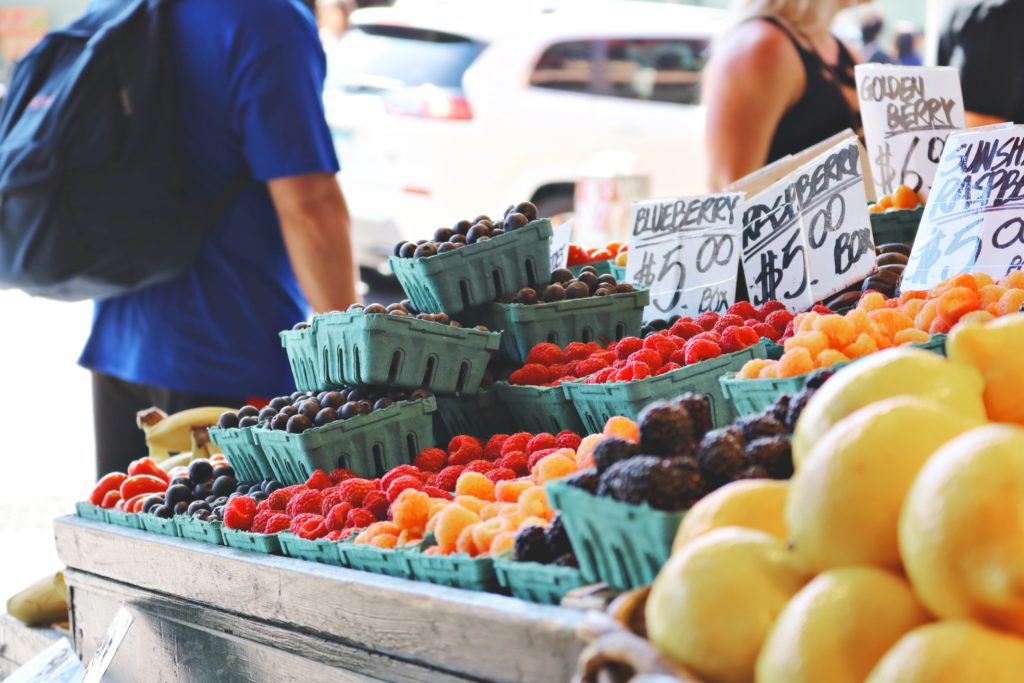
The Arab Spring refers to a series of anti-government protests, uprisings and armed rebellions that spread across much of the Arab world in the early 2010s. Largely a response to corruption and economic stagnation, the Arab Spring started over a shortage of bread.
When grain prices spiked in 2007, bread prices in Egypt rose 37%. Chronic unemployment meant more people depended on subsidized bread, but the government didn’t make any more available. This led to social unrest that eventually unseated Egyptian President Mubarek.
The Tunisian uprising started in more dramatic fashion, when a young man running a vegetable stand set himself on fire to protest corruption. Many believe his act of self-immolation was the start of the Arab Spring.
By 2018 the Arab Spring’s momentum had slowed considerably, however the following year, mass protests started happening in other parts of the world. Many were sparked by anger over the economy, rising inequality and high costs of living.
In Chile, a small protest over a hike in subway fares escalated into widespread civil unrest resulting in the deployment of the Chilean army and the calling of a state of emergency. The events culminated in over a million people taking to the streets of Santiago to protest against economic and social inequality. Chile has one of the highest levels of inequality in the OECD, its economy dominated by powerful oligarchs including President Sebastián Piñera, worth an estimated $2.8 billion.
Also in 2019, Colombia saw one of its biggest anti-government protests; Indonesia passed a law that significantly weakened an anti-corruption commission, resulting in thousands clashing with police; and in Haiti, the poorest country in the Americas, an angry mob protesting over corruption, inflation and scarcity of goods, demanded the resignation of their president.
Protests also flared up again in the Middle East. In Iran, a 50% hike in gasoline prices sparked demonstrations against government corruption. Clashes with authorities left hundreds dead. In Iraq, protests over unemployment and corruption escalated calls for a new government, while in Lebanon, there were widespread protests after the government proposed a tax on What’s App calls, and passed an unpopular austerity budget. The demonstrations quickly mushroomed into a broader protest against high unemployment, sectarian rule, corruption, and the government’s failure to provide basic services like electricity and sanitation. The top 1% of Lebanon receives about 25% of its income (World Inequality Database).
According to the The Guardian, Protesters maintained that the pampered elite, rather than strapped working people, should foot the bill for the country’s economic problems.
Inequality
The 2019-20 demonstrations in Hong Kong were mostly blowback for China’s encroachments on the city’s autonomy and democratic institutions, however the anger was also directed at the exorbitant cost of living. If you thought Vancouver was expensive, Hong Kong is the world’s most unaffordable city, with rents higher than London or New York. It is also among the most unequal, with 93 billionaires holding a combined worth of over $300 billion, while one in five residents lives in poverty.
Globally, Oxfam calculated that 26 people have the same amount of wealth as 3.8 billion in the world’s bottom half. Inequality is even starker in the United States, where the three wealthiest individuals have as much as the bottom 160 million.
The Guardian observes that right-wing political movements and the rise of populism over the last few years have their roots in the financial crisis of 2008-09. Not only did the Great Recession result in significant job losses and millions of Americans losing their homes from the sub-prime mortgage crisis, it also “stripped the sheen off global capitalism”:
In the US alone, the great recession erased about $8tn in household stock-market wealth and $6tn in home value. From 2003 to 2013, inflation-adjusted net wealth for a typical household fell 36%, from $87,992 to $56,335, while the net worth of wealthy households rose by 14%. Workers without college degrees and low-income Americans were especially hard hit.
In addition to causing such widespread deprivation, the 2008 crash stripped the sheen off global capitalism. Just as the Iraq war undermined the authority of the US foreign policy establishment, so did the financial crisis discredit the bankers, asset managers, ratings agencies, and regulators responsible for running the world economy. Compounding that damage was the government’s decision to bail out many of the same institutions – Bank of America, Citigroup, Goldman Sachs, JPMorgan Chase and Wells Fargo – that had caused the crisis.
A December 2021 World Economic Forum report found the pandemic has exacerbated existing inequalities. Among its conclusions, the report says:
- The richest 10% of the global population currently take home 52% of the income. The poorest half earn just 8%.
- On average, an individual from the top 10% will earn $122,100, but an individual from the bottom half will earn just $3,920.
- The poorest half of the global population owns just 2% of global wealth, while the richest 10% own 76%.
- Over the last two decades, the average income gap between the top 10% and bottom 50% of individuals within countries has almost doubled.
- 2020 marked the steepest increase in the global billionaires’ share of wealth on record.


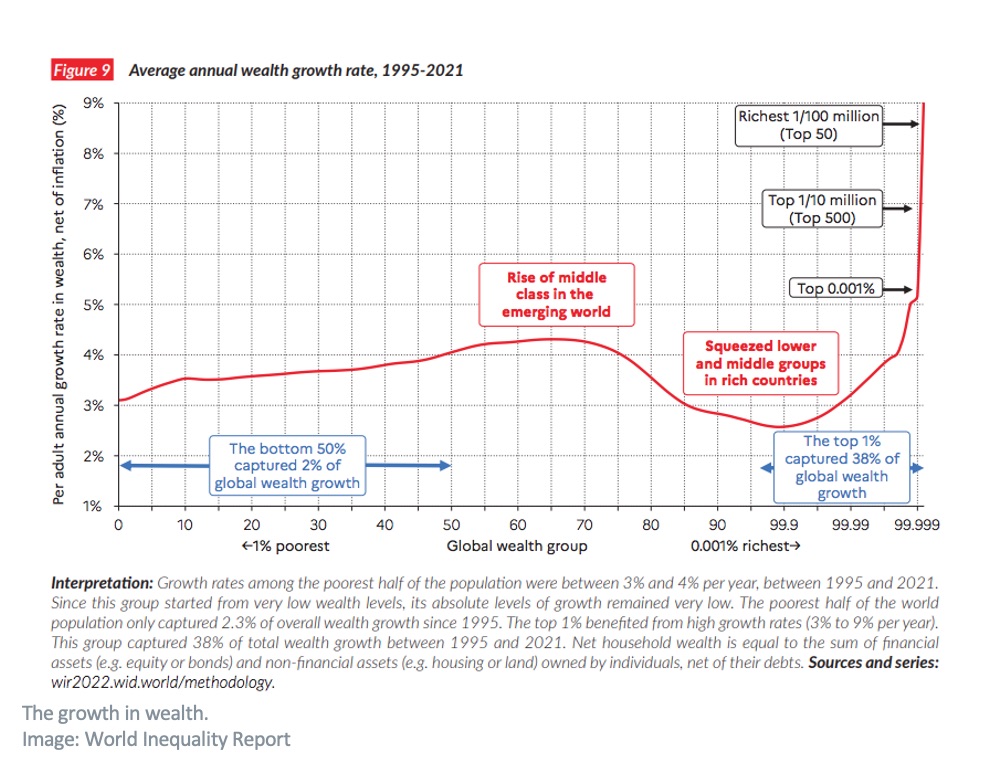
Of course, inequality has been with us since well before globalization, even pre-dating the Industrial Revolution.
But that doesn’t make it okay, nor desirable. Taken to extremes, inequality causes social upheaval, and often, violent revolution. China, Russia and France are among the countries that experienced bloody worker or peasant-led insurrections. The US Civil War was to some extent caused by inequality, with the Unionist north fighting the Confederate South which supported an economy based on the most unequal relationship between human beings known to man: slavery.
Arguably the most visible manifestation of inequality in recent years, is the polarization of politics and the rise of populism in the UK, the US, Europe and elsewhere. Populism was largely responsible for Brexit and the election of Donald Trump, while in Europe, there has been growing support for new political movements on both ends of the political spectrum.
As the rich get richer and the poor get poorer, trust in government has been significantly eroded.
Continued distrust of elected and appointed public officials is reflected in the anti-vax movement, and the “trucker convoy” which rolled across Canada to Ottawa demanding an end to covid-19 restrictions.
Food inflation, shortages, hunger
A more direct, and disturbing, consequence of inequality is the capacity of people to feed themselves. Food insecurity has doubled in the past two years, and the World Food Program estimates 45 million people are on the brink of famine.
Earlier this year, the WFP identified 20 “hunger hot spots”, four of which require humanitarian actions to prevent starvation and death: Ethiopia, Nigeria, Sudan and Yemen.
Russia’s invasion of Ukraine has only added to the misery. Not only has the war resulted in 2.5 million displaced Ukrainians seeking refuge in neighboring countries, it threatens to stop shipments of key agricultural commodities that could be the tipping point of a full-blown global food crisis.
The most important of these is wheat. Between Russia and Ukraine, they account for 25% of global supplies. Exports of wheat, corn, sunflower oil and other foods normally account for over a tenth of all calories traded globally, but shipments from both countries have all but dried up.
While Western sanctions haven’t directly targeted wheat, trade from Russia has ground to a standstill, while in Ukraine, growers for obvious reasons are finding field work too dangerous. Some have joined the resistance, only a few weeks before spring planting. Many fields in Ukraine this year could thus lie fallow.
“The potential is here for a serious hole in world grain supplies in 2022,” Bloomberg quoted Scott Irwin, an agricultural economist at the University of Illinois.
Wheat is not only used to make bread, it is found in other carbohydrate-rich foods including noodles and couscous.
Supply chain disruptions from the “bread basket of the world” pushed benchmark wheat futures traded in Chicago to a record-high, Tuesday, while corn earlier this month touched a decade high.
Export flows are expected to be interrupted for months even if the war were to end immediately.

It couldn’t have come at a worse time for global food supplies. While the pandemic caused lineups at food banks and empty shelves at grocery stores, actual supplies were never in question. That is no longer the case. Grain stockpiles are poised to decline for a fifth straight year, due to a combination of higher shipping costs, energy inflation, extreme weather and labor shortages. If the world were to become short of grains, people would starve; wheat, corn and rice account for over 40% of all calories consumed.
Even before the conflict began, food prices were at record highs, the benchmark UN index increasing more than 40% over the past four years.
Beyond wheat, corn and edible oils, Russia is a major producer of nitrogen, potassium, and phosphorus fertilizers. The country is the world’s largest exporter of urea and no. 2 for potash.
Pre-war, the fertilizer market was getting pummeled due to extreme weather, plant shutdowns and rising energy costs — in particular natural gas, the main feedstock for nitrogen fertilizer.
This week the European natural gas benchmark surged as much as 79%, to the equivalent of more than $600 a barrel, on concerns over the availability of the fossil fuel. Russia supplies about a third of European gas demand, and has threatened to cut flows via the existing Nord Stream 1 pipeline to Germany, as retaliation over Western sanctions.

Modern farming simply cannot do without fertilizer; its higher cost must be borne by producers and so higher food prices are likely going to be “baked in the cake” for several years.
Everyone from ranchers to farmers, greenhouse growers and orchardists will be affected.
Russia’s efforts to halt fertilizer exports threaten to push the prices of crop nutrients to record levels and exacerbate food inflation.

In December the US slapped sanctions on a major potash supplier in Belarus, adding to concerns over global supplies.
Farmers are having to reduce their plantings due to urea shortages. Any reduction in nitrogen, which must be applied annually, will immediately impact crop yields, severely impacting food staples like corn and wheat.
For most growers, they have no choice but to pass on the added costs to their customers.
Having reached its highest level since 2011 in January, global food inflation continues to climb.
Data from the United Nations shows world food prices reached an all-time high in February — a year on year increase of 20.7% — driven by an 8.5% increase in the FAO Vegetable Oils Price Index, which also hit a new pinnacle.
The dairy, cereal and meat price indices all punched higher in February. According to an FAO economist,
“Concerns over crop conditions and adequate export availabilities explain only a part of the current global food price increases. A much bigger push for food price inflation comes from outside food production, particularly the energy, fertilizer and feed sectors.”
“All these factors tend to squeeze profit margins of food producers, discouraging them from investing and expanding production.”
United States inflation rose 7.9% in February, with food and energy costs pushing prices to their highest in 40 years. Gasoline, groceries and shelter were the biggest contributors to the CPI gains, with food prices and food at home adding a respective 1% and 1.4%, the most since April 2020.
US breadmakers fear soaring costs, as turmoil in the Black Sea drives up futures tied to US wheat used to make cookies and cakes and other common foods. Prices on March 1 reached the highest since 2008.
“It may be weeks, it may be months, but I definitely think we’re going to see further food inflation across the board, particularly anything that’s got grains in it,” Robb MacKie, chief executive of the American Bakers Association, told AJOT, the American Journal of Transportation.

Indeed the war in Ukraine is accelerating a global food crisis that is reverberating across the world, in countries that literally depend on the region for putting food on the table.
According to Goldman Sachs, the conflict has choked off over 25% of the world’s supply of grain, putting the market on track for the “sharpest shock” since the 1970s. Higher prices are speeding up food inflation and raising concerns for countries reliant on foreign supply.
On Wednesday Ukraine banned a wide range of agricultural products, including barley, sugar and meat.
The same day, a crowd of 500 protesters gathered in southern Iraq to denounce the skyrocketing prices of cooking oil and flour — goods heavily imported by Middle Eastern countries.
“The rise in prices is strangling us, whether it is bread or other food products,” retired teacher Hassan Kazem told AFP news agency, via Al Jazeera. “We can barely make ends meet.”
Gallup, the polling firm, provided data indicating which countries are most likely to suffer from a wheat supply disruption. Topping the list is Turkey, which received 75% of its wheat imports from Russia and Ukraine in 2019. Last year 51% of Turks reported being unable to afford food. The country’s vulnerability is heightened by a lingering economic crisis and hyperinflation.
Second is Egypt, which imported 70% of its grain from Russia and Ukraine in 2019. 41% of Egyptians said they lacked money for food at some point in the last 12 months. Growth in Egypt’s GDP over the last two years would likely be wiped out by food price increases brought about by the war in Ukraine.
Note that Russia’s low wheat harvest in 2010 due to drought was a major factor in the Arab Spring that broke out in Egypt. Egyptians are worried that prices for the subsidized loaves of bread they depend on could rise for the first time in four decades.
Number three Kenya received just over a third of its wheat imports from Russia and Ukraine in 2019, however nearly seven in 10 Kenyans reported having lacked money for food in the last year. This is substantially higher than the percentages reported in Egypt and Turkey.
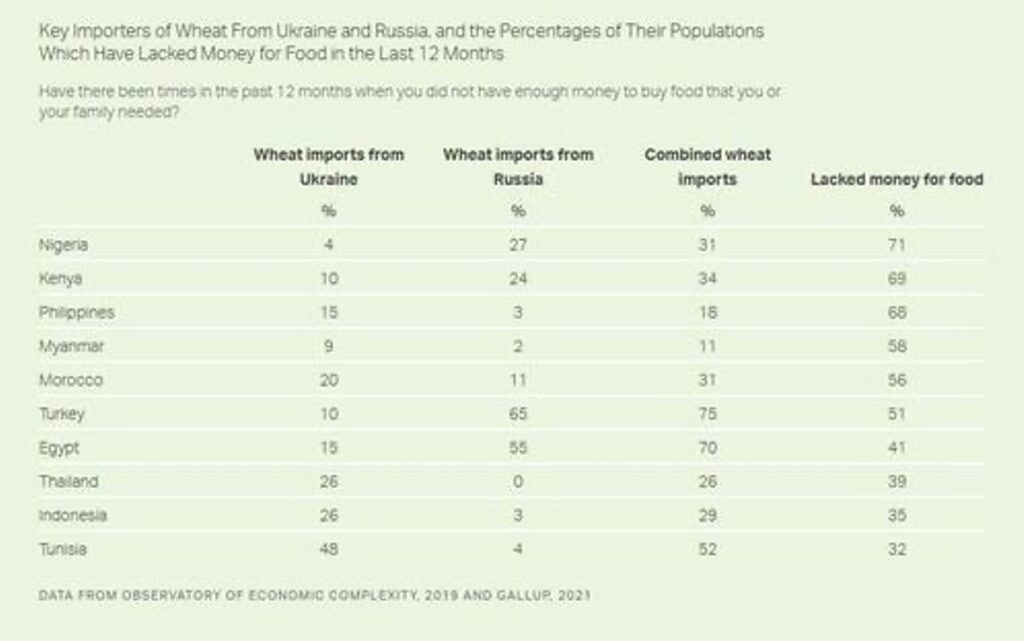
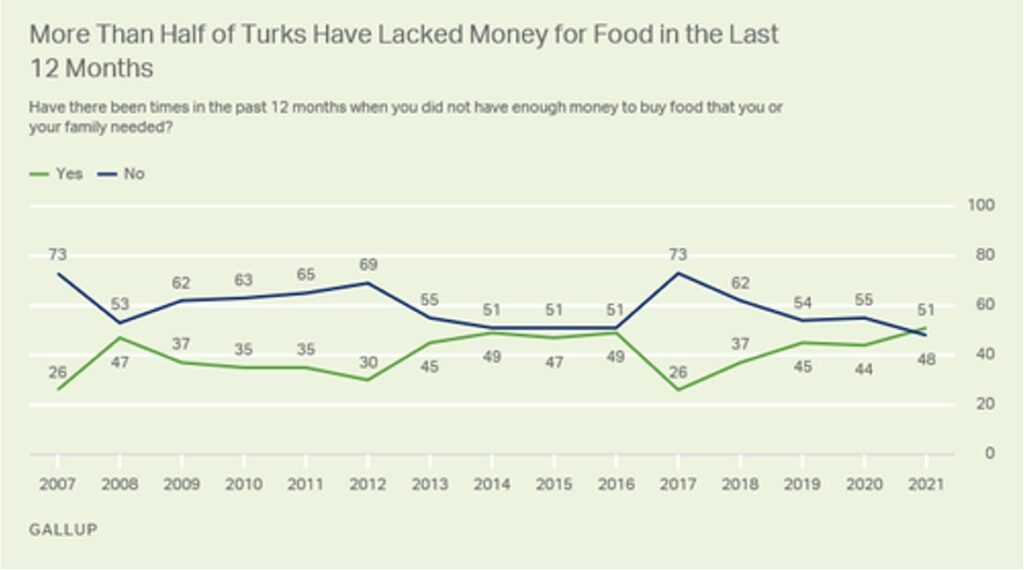
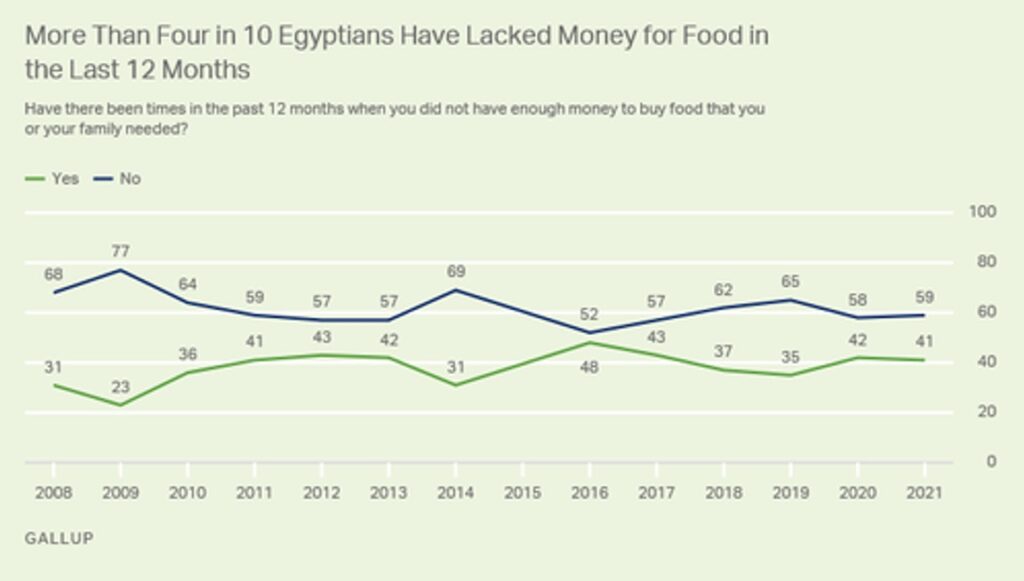
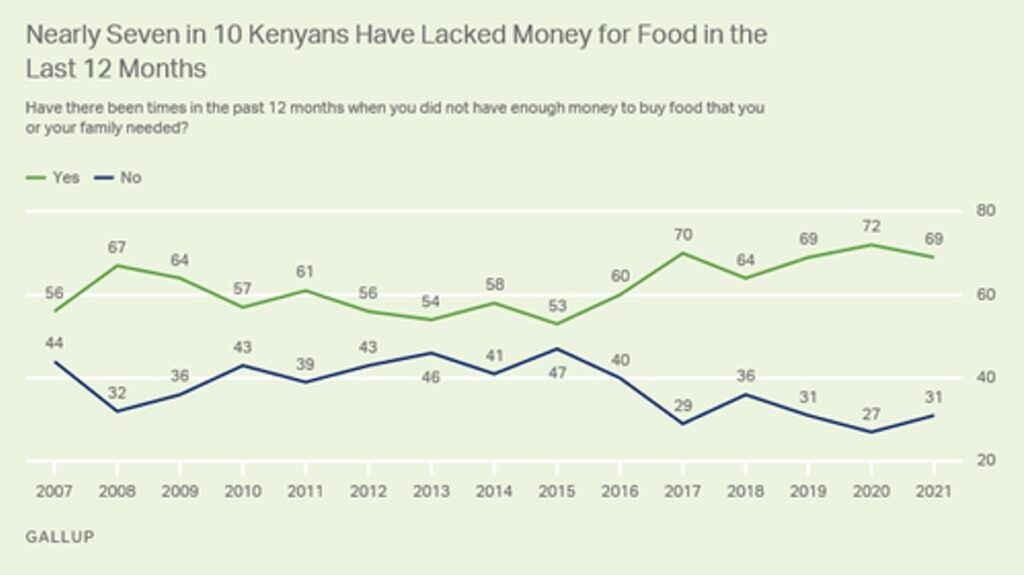
Adding to current supply concerns for agricultural commodities, some countries are hoarding stockpiles, while others are restricting exports. Among those protecting their crops, ensuring they have enough for themselves, Hungary is banning grain exports and Serbia’s president announced Wednesday it will halt exports of wheat, corn, flour and cooking oil.
Indonesia tightened curbs on exports of palm oil, used in a range of food products including biscuits, margarine, laundry detergents and chocolate. Palm oil prices have risen by more than 50% this year, while soybean oil prices have climbed almost 40%.
Countries that could normally fill the void are themselves having production problems. A drought in Brazil, a major supplier of corn and soybeans, has ruined crops, while in Canada and the US, a prolonged period of hot and dry weather in 2021 also wilted fields and forced some ranchers to cull their herds due to expensive or hard to find feed.
Although the surge in wheat prices is expected to entice Canadian farmers to sow more acres, it likely won’t be enough to fill the global shortfall. This is because last year’s drought reduced up to 40% of Western Canada’s grain output, and large parts of the Canadian prairie provinces remain under extreme drought conditions, as seen on the map below.
Stockpiles are reportedly insufficient to support more wheat exports until growers harvest a new crop. Government data shows wheat inventories were at 15.6 million tons at the end of December, 38% less than a year earlier.
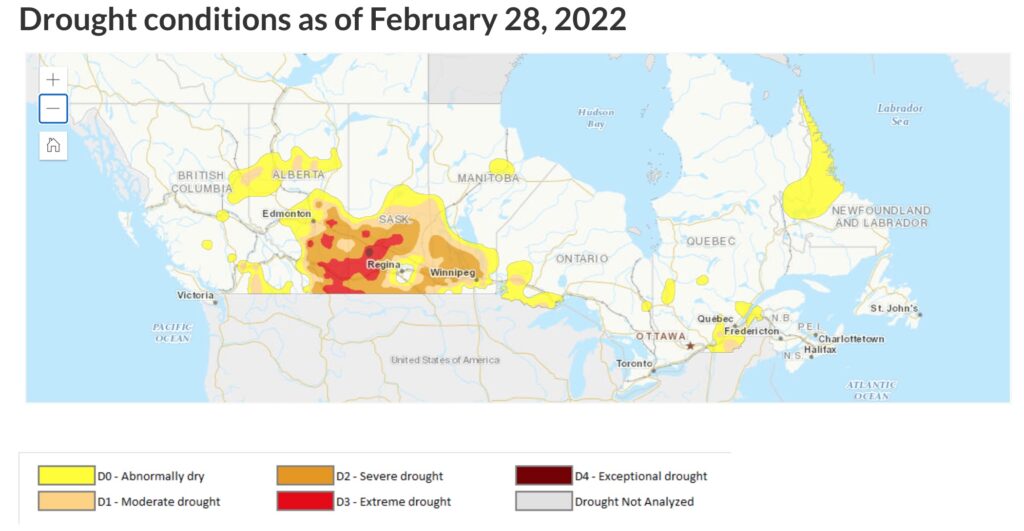
Globally, wheat farmers are already running at full tilt and most northern hemisphere nations have limited ability to grow more because the crop has already been planted.
In Australia, which had a bumper wheat crop last year, any increase in acreage is expected to be marginal. The country is set to ship a record 25.3 million tonnes this year, but trucking, rail, port and staffing constraints mean it won’t be able to fill supply gaps at least in the near term, Reuters said.
Ship berths Down Under are booked for the next few months on both the east and west coasts, and there is a shortage of equipment, including ship loaders, to move cargo.
It is uncertain how long disruptions in the food chain will last. We do know that hardship will result in countries most dependent on Russia and Ukraine for food imports, including food insecurity, hunger, starvation and death.
For the most part this means the developing world, where populations already struggle to afford food. Ukraine is the largest supplier of wheat to the United Nations’ World Food Program, but if the WFP is unable to buy its wheat, it will have to go to other more expensive sources, leaving less aid to provide to those at the greatest risk.
This includes Russians, many of whom oppose the war. As economic sanctions hurt the economy, food insecurity and hunger will increase, just as sanctions in Iraq during the 1990s were linked to the deaths of half a million children due to malnutrition.
The number of people facing starvation worldwide spiked from 80 million to 276 million before the invasion, due mostly to covid lockdowns. That figure is set to rise again.
Meanwhile experts are warning that the global food crisis resulting from the war in Ukraine will cause “hell on earth” for food prices.
“For me, it’s not whether we are moving into a global food crisis — it’s how large the crisis will be,” Svein Tore Holsether, head of agri company Yara International, told the BBC, via Summit News.
Quoting from the article, David Beasley, head of the World Food Program, was even more pessimistic, stating that “Just when you think hell on earth can’t get any worse, it does”:
Noting that countries like Lebanon, Yemen, Syria, Tunisia are dependent on Ukraine for around 50 per cent of their grains, Beasley noted the stunning turnaround.
“So you’re going from being a breadbasket to now, literally, having to hand out bread to them. It’s just an incredible reverse of reality,” he said…
Meanwhile, Russia has also threatened to close its main gas pipeline to Germany if the west bans Russian oil, a move that would cause oil prices to more than double to $300 a barrel.

Unaffordability
Accompanying the unfolding global food crisis is a crisis of unaffordability. Consumers everywhere are getting squeezed on housing costs, fuel, rising inflation and a loss of purchasing power. Combined, it adds up to a perfect storm that, if nothing changes, will imo lead to a breaking point, when people have nothing left to lose and revolution is seen as the only means of forcing social and economic change.
As mentioned inflation is rampaging across much of the globe, including in the United States and Canada where it has hit multi-decade highs.
We’ve detailed the surge in the prices of agricultural commodities but it’s also energy and minerals. On Monday, March 7 Bloomberg wrote The rally from oil to wheat and natural gas to nickel is threatening a still-fragile economic recovery from the pandemic, exacerbating an inflationary surge for energy-consuming nations and worsening a cost-of-living crisis for millions.
Let’s take a closer look at this growing crisis of unaffordability.
For most families and individuals, housing represents the biggest chunk of their monthly budget. When talking about housing, we need to include home prices, mortgage rates and rent.
For the past several years, expensive housing has been restricted to the major cities, especially Toronto and Vancouver. Lately, however, home price increases have fanned out beyond the large population centers.
Over the past year, a typical US home increased almost 20%, from about US$272,000 to $326,000. According to Bloomberg, that uptick combined with rapid home-price appreciation to push the average monthly mortgage payment to a record high.
The average US home-loan payment of $1,230 for a 30-year, fixed rate loan, is now the highest ever — up 36% from the average $905 a year ago and a 6% increase from January.
The US Federal Reserve is set to hike the federal funds rate by a quarter percentage point, resulting in mortgage rates climbing higher, further squeezing buyers as they scramble to lock in.
Bloomberg reports evidence of buyers getting discouraged by the one-two punch of higher prices and higher mortgage rates. A gauge of US home-loan application recently fell to the lowest level since 2019.
Meanwhile in Canada, housing prices are expected to keep rising in 2022 as demand outpaces supply.
According to the latest House Price Survey by Royal LePage, the average Canadian house increased 17.1% in the fourth quarter of 2021, to CAD$779,000. The biggest price increases were seen across much of Ontario and in major cities in British Columbia, according to the report, via Global News.
On March 2 the Bank of Canada raised interest rates by 25 basis point to 0.5%, provoking bumps in fixed-rate mortgages by all of the big banks. It’s the first time since 2018 that the BoC has hiked the overnight interest rate to curb inflation and cool the real estate market.
The BoC Housing Affordability Index shows the share of income needed for housing costs. A fall in the index means housing affordability is improving, and vice versa. Unfortunately the index has been trending up for some time. According to Better Dwelling, a home across Canada in the third quarter of 2021 required 37% of disposable income, which is the highest ratio going back 13 years.
Metro Vancouver has been, and continues to be, the country’s least affordable housing market, with RBC estimating the average household in the region must allocate 64% of income to cover homeownership costs.
Is it any more affordable to rent? In most cities, probably not. CMHC’s annual rental market report, released in February, showed the average rent for a two-bedroom home in 37 areas studied, increased to $1,167 last year, a 3% rise from 2020.
Unsurprisingly, Vancouver and Toronto had the highest average monthly rents, increasing by a respective 2.4% and 1.5%. Renting a two-bedroom in the Greater Toronto Area costs $1,666/mo while in Vancouver it will set you back $1,824.
CMHC found that a Vancouver renter would have to work 198 hours per month (nearly 50 hours per week) to keep rent at 30% of their monthly gross income, the threshold for affordability. In Toronto, it would take 178.3 hours.
US rents are also climbing. An analysis quoted by The Guardian found rents in the US jumped 14% in December 2021 to $1,877 a month, the largest rise in more than two years.
According to Zero Hedge, March shelter inflation was 4.74%, up from 4.36% in January and the highest since May, 1991. March rent inflation was 4.17%, the most since July, 2007.
Like housing prices, rents are a function of supply and demand. According to The Guardian, There is less housing available for rent or sale now than anytime in the past 30 years, with supply shortages worsening, contributing to rising rental costs, inflation, and making home ownership more unattainable.

Another significant component of a North America family’s budget, gasoline prices, are also going bonkers. Though complaining about the price of fuel while the citizens of Ukraine are bombed into the stone age obviously invites some “first world problems” perspective, for other than high-income Canadians and Americans it’s a big deal.
The nationwide average for regular gas is now $4.32 a gallon, according to AAA. CNN said gas prices are climbing faster than when Hurricane Katrina slammed into oil platforms and refineries along the US Gulf Coast in 2005.
The average gas price in Canada hit $1.87 per liter on Thursday, up CAD$0.21 from last week, according to GasBuddy.com. Vancouver motorists have the most expensive gas in North America, with prices marching up to $2.09 a liter on March 6, a record for the region. (1 gallon = 3.7 liters)

Stagnant wages
Skyrocketing home prices. Higher mortgage rates and rents. Ever-increasing grocery bills. Gas prices so high, they might just be the tipping point that pushes many car owners to purchase a hybrid or an EV.
The higher cost of living would be manageable if a worker’s wages were keeping up with inflation. Unfortunately there is mounting evidence they are not.
We know from a previous article that the purchasing power of most Americans earning wages or collecting a salary, has stagnated.
Americans’ paychecks may have increased but their purchasing power hasn’t. According to Pew Research, despite some ups and downs over the past several decades, the real average wage in 2018 had the same purchasing power it did in 1978.
This is all down to inflation and the inability of fiat currencies to protect against it.
The chart below by Trading Economics shows US wage and salaries growth holding steady at about 5% since 2017, decreasing in the early part of 2020, then climbing sharply in 2021, as the US economy experienced a shortage of workers.

Post-pandemic recovery in February saw employers adding 678,000 to payrolls, with unemployment falling to 3.8%, however average hourly earnings were virtually unchanged from January.
Indeed US wages have failed to keep up with the rate of inflation. Wages (average hourly earnings) in February dropped on a year on year basis for the 11th straight month.
Regarding inflation, note that the data released this week for February does not include the crazy commodity price hikes we have seen lately, including wheat, oil, natural gas and nickel, the latter rallying 250% in two days. Nor does it reflect soaring house inflation. Next month’s CPI is therefore bound to be worse, likely much higher than 7.9%.
As Wolf Richter over at Wolf Street wisely remarks,
Inflation is not a sign of growth, and it’s not a sign of anything positive. It’s just a sign of the loss of the purchasing power of the consumer’s dollar, including the purchasing power of dollar-denominated labor…
In February, the purchasing power of $100 in January 2000 dropped to a new record low of $59.46. And this is why Americans are in such a sour mood:

The wage and salary earner is literally getting screwed every day because the value of the dollar is being devalued by a fractionally small amount. Over time, however, the diminished value is huge.
In the US there was an increase in inflation for every decade except the Depression. The dollar has lost 90% of its purchasing power since 1950.

Conclusion
We started this article writing about social unrest.
Food inflation has historically been the catalyst for many popular uprisings, from the French Revolution to the Arab Spring. When people can’t afford to eat, when work has dried up and they can no longer feed their families, when housing represents more than two-thirds of income, and filling up the car costs more than an expensive dinner for two, we might have reached a point of reckoning.
The covid-19 pandemic pushed nearly 300 million people to the brink of starvation. Just when it appeared to be letting up, we’re hit with a new crisis, the war in Ukraine. The conflict is almost certain to increase the ranks of the impoverished.
Among the countries most likely to be impacted by wheat supply disruptions are Egypt, Turkey and Iraq. The Middle East has already been hit with a wave of uprisings partly caused by food price inflation, could an Arab Spring 2.0 be far behind? And we also need to keep our eye on Russia. The ruble has lost more than 64% to the US dollar year to date, a record low, and Western sanctions are starting to bite. The war isn’t the fault of ordinary Russians, many of whom are going to become food insecure if economic conditions continue to worsen.
People are getting mad, and it isn’t only rising food prices. Inflation in the United States is at levels last seen in 1982, and it’s not much better in Canada. But in the early ‘80s, at least you could afford to buy a house, even with interest rates in the double digits. For many North Americans, that is no longer the case. Home inflation is running rampant, rents are higher than ever, and workers’ wages and salaries aren’t keeping up. As inflation eats away disposable income, nearly two-thirds of Americans (64%) are living paycheck to paycheck.
Covid exposed the weaknesses in our supply chain. The war has revealed how some of the countries most vulnerable to food price hikes, and social unrest, are dependent on the Russian-Ukrainian bread basket.
Globalization brought with it the mentality that all countries are free traders, and friends. But it seems globalization doesn’t work very well when commodity exporting nations are fighting each other.
Climate change. Covid. The war in Ukraine. All have revealed the downsides of globalization and in my opinion it’s only a matter of time before the people rise up.
Everything is Broken
Broken lines, broken strings,
Broken threads, broken springs,
Broken idols, broken heads,
People sleeping in broken beds.
Ain’t no use jiving
Ain’t no use joking
Everything is broken.
Broken bottles, broken plates,
Broken switches, broken gates,
Broken dishes, broken parts,
Streets are filled with broken hearts.
Broken words never meant to be spoken
Everything is broken.
Seem like every time you stop and turn around
Something else just hit the ground
Broken cutters, broken saws,
Broken buckles, broken laws,
Broken bodies, broken bones,
Broken voices on broken phones.
Take a deep breath, feel like you’re chokin’,
Everything is broken.
Every time you leave and go off someplace
Things fall to pieces in my face
Broken hands on broken ploughs,
Broken treaties, broken vows,
Broken pipes, broken tools,
People bending broken rules.
Hound dog howling, bull frog croaking,
Everything is broken.
R.L. Burnside
John Lennon sang about wanting a revolution, well we just might get one.
I don’t know what the trigger will be, I only know that I want to be prepared and as far away from it as possible when it happens.
(By Richard Mills)
More News
Why pause in US anti-corruption enforcement will hurt mining firms, not help them
In the race for critical minerals, bribery is not a guaranteed foot on the accelerator.
April 09, 2025 | 08:00 am
Gold price rallies over 3% as trade war heats up
"Ultimately gold continues to be seen as a hedge against instability here," an analyst said.
April 09, 2025 | 07:56 am
Column: Annual zinc processing benchmark looks bullish but isn’t
Zinc has been the consistent under-performer of the LME base metal pack since the start of 2025.
April 09, 2025 | 07:55 am
{{ commodity.name }}
{{ post.title }}
{{ post.excerpt }}
{{ post.date }}




Comments